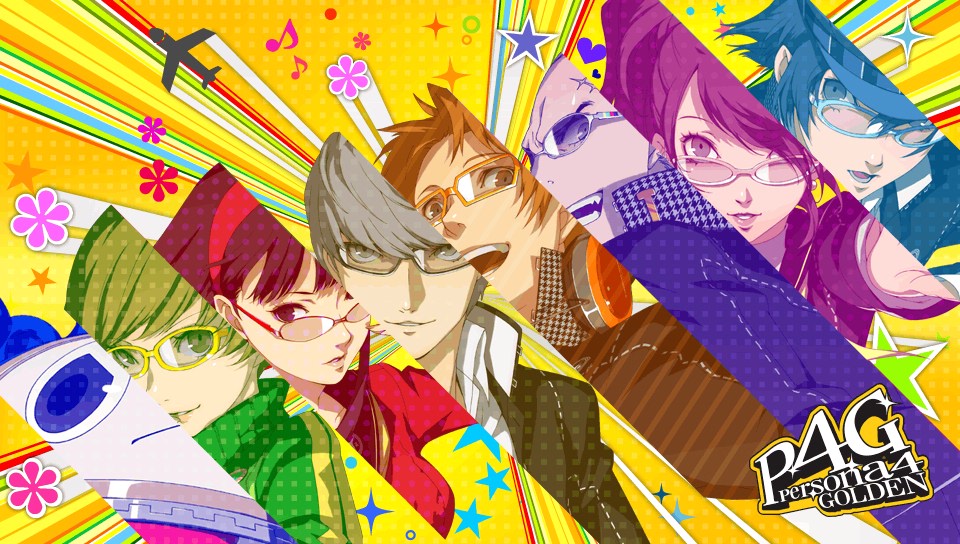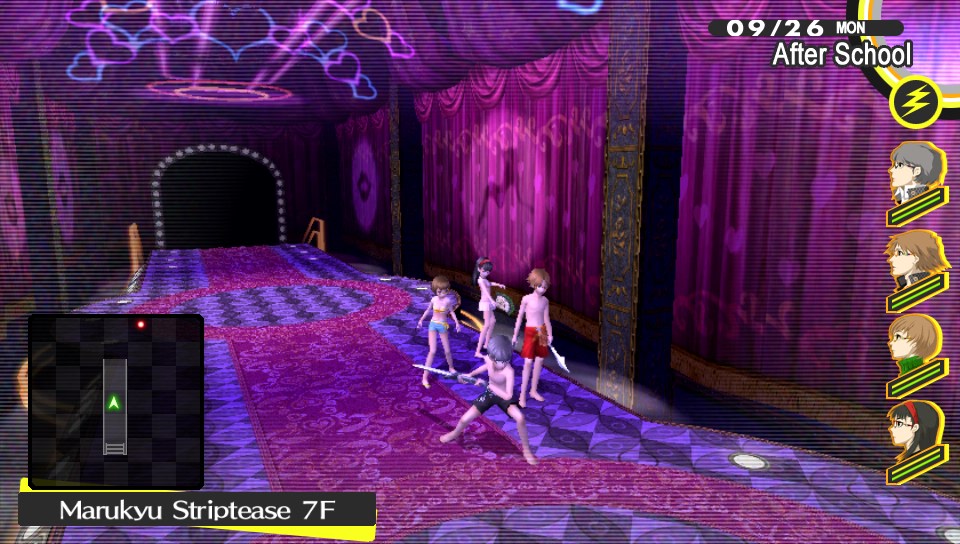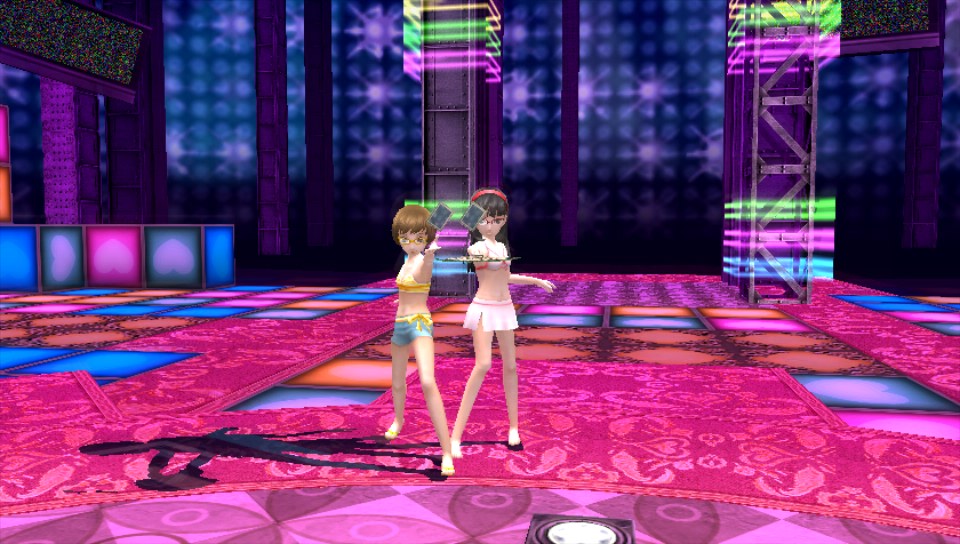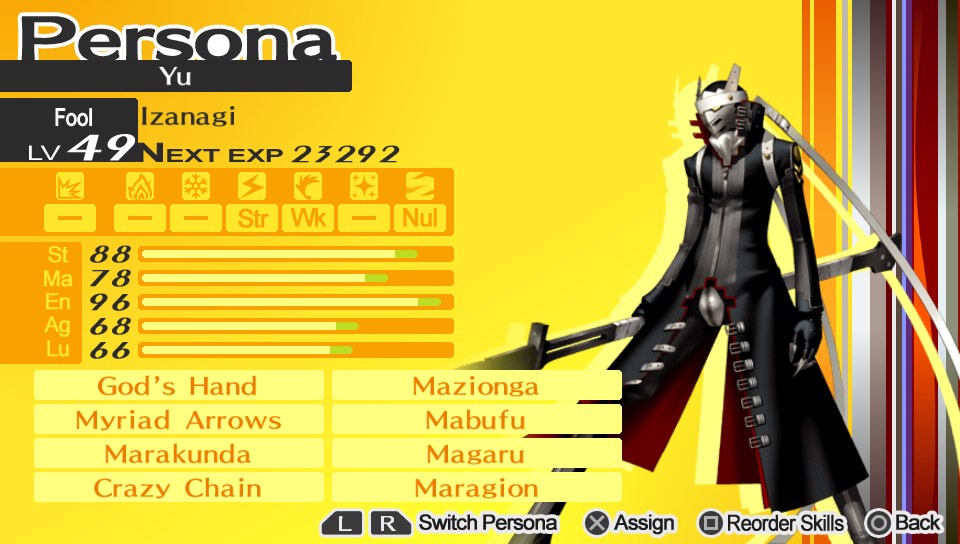Persona 4 Golden Review
When I initially wrote my review, it ended up being more schizophrenic than I had intended, so I’m splitting it into two parts. If you’re a newcomer to the game or series, read part one of my review. If you’re a veteran of the series, read part two. If you’re a lazy asshole, go to the TL;DR version at the bottom.
Part One: Newbies
Persona 4 isn’t exactly a triple-A blockbuster RPG like Final Fantasy, Mass Effect, or The Elder Scrolls, but it’s still critically acclaimed and quite the cult classic. If you haven’t heard about it before, it’s basically a visual novel-dungeon crawler-Pokémon hybrid. During the day, you go about your business as a normal high schooler, building relationships with classmates and townspeople, studying for school, or going out. Eventually, you become a Pokémon trainer Persona user, and you can go dungeon crawling to help solve the serial murder case plaguing Inaba. Think of it like Scooby-Doo meets Pokémon. It has a lot more going on, but I don’t want to spoil too much for first-time players.
Anyway, although I believe P4 is the third best game ever made, there were plenty of improvements that could’ve been made. Atlus must’ve understood the flaws and complaints people had with the game because they fixed many of them for Persona 4 Golden, the remake on the PlayStation Vita. Virtually every aspect of the game has been improved: The technical aspect, the gameplay (combat and movement), the graphics, the sound, the Social Links. Everything. Don’t worry about playing the original if you’re new to the game. P4G is basically what P4 should’ve been.
From the get-go, you’re greeted to a hip opening theme featuring the main characters dancing along. The colors are vibrant and the lyrics still nonsensical, but hey, that’s what we all love about Atlus games. In general, the soundtrack ranges from upbeat to emotional as appropriate. When the opening finishes, you’re given a fairly standard menu: You can change options like text speed, auto-skipping, etc. Starting a new game will ask you to choose a game difficulty: Very Easy, Easy, Normal, Hard, and Very Hard. The game doesn’t reveal the actual differences, however. For example, on Very Hard difficulty, you earn 40% less experience and money per battle compared to Normal, and Shadows deal more damage, but the game doesn’t tell you that.
After choosing your settings, you’ll enter the high-school life simulator portion of the game. You control Brotagonist to roam around town and talk with people to build relationships (called Social Links in the game). You’ll spend the majority of your time learning more about the various denizens of Inaba and the serial murder case. This type of game is very different from 99.9% of Western titles, but Atlus does a excellent job of getting you integrated into the school and game.
Occasionally, you’ll have to go dungeon crawling to progress the main storyline, and that’s where the traditional JRPG elements come into play. As I’ve said before, the game is like Pokémon with some differences. You enter combat by striking Shadows (the primary antagonists of the game) onscreen. Hitting them from behind will give you an advantage, while getting hit first may give them the advantage. In combat, you control Brotagonist and up to three other Persona users. Personas have both magical and physical attacks that cost Spirit Points (SP) or Hit Points (HP), respectively. You can also attack with each character’s equipped weapon. You essentially want to exploit the enemies’ weaknesses because it allows you to attack again. If you knock every enemy down, you can perform a devastating All-Out Attack, which usually deals a ton of damage to every enemy. Unlike other turn-based RPGs, P4G’s combat flows very well because of this “One More” system. Some battles require a little more strategy, but the combat system here is about as fluid as you’ll get with a turn-based RPG.
The serial murder case is the overarching storyline, and it’s a very good one. There are plenty of side stories, though, that break up the tension and give you a little breathing room before jumping into the next stretch of the investigation. Each Social Link event provides ample characterization, and by the end, you really feel like you’ve connected with someone from Inaba. Everyone has their own unique problem or quirk that sets them apart, just like real life. The strong cast of principal and supporting characters is where P4G shines.
It mixes orthodox and unorthodox. Its addictively fast yet strategic gameplay is a massive improvement on the formulaic JRPGs of yesteryear. Even if you’re not a hardcore RPG fan, you can play the game and enjoy each dungeon as it comes with no grinding involved if you don’t want to. The still-catchy-after-all-these-years tunes and deep character interactions are what will leave an impression after your more than 50-hour journey comes to a close.
Part Two: Oldies
P4G massively improves on the original game while adding a lot of worthwhile content to keep veterans of the series entertained for several playthroughs. Unless you’re using a Max Social Link Guide, you’re unlikely to max out all your parameters again in addition to the many, many Social Links.
Let’s jump right into the gameplay. You’ll notice the difference in the dungeon mode right away. There are no longer any floating Shadows, and it’s really easy to engage them compared to the original. Some might think of it as “dumbing down,” but I welcome the change. It’s not fun to just sit there and wait for a Shadow to slowly turn around so you could hit it. It’s also different from Persona 3’s Maniac Mode in that getting hit by a Shadow or hitting it head on doesn’t always lead to an Enemy Advantage. Another change that was dearly needed is choosing which skills to pass on when fusing. No longer do you have to listen to “Aria of the Soul” over 9,000 times just to fuse the perfect Persona.
The quality of life changes were sorely needed, but some changes aren’t quite as welcome and only serve to lessen the experience for veterans. Shuffle Time can now level up Personas, skills, and stats, thus making it extremely lucrative to use one Persona forever. It’s good if you really like Izanagi, but terrible for game balance. It makes boss encounters more about brute force. Your teammates can die, but your Izanagi with God’s Hand, Myriad Arrow, every Ma-spell, and 90+ Endurance sure won’t. I at least commend Atlus for getting rid of immunities for the upgraded Persona forms. When only healers had weaknesses, it was way too easy to cover up for one weakness, but now everyone maintains their initial weakness. Thus, battles are less predictable, and that’s important in a numbers game like Persona. That change isn’t enough, though. Gold Shadows are now more abundant and easier to kill due to the aforementioned Shuffle Time changes. This makes leveling, even in Very Hard, stupidly easy because they give you a ton of experience — nearly 70-80% of a level every time. Or you know… maybe it just feels fast because I get to stare at Yukiko in a bikini all day.
Okay, so the RPG portion has gotten a lot easier, but maybe that’s good for some people. I, however, prefer games to have a sense of urgency or looming threat of death. That’s what keeps me interested in combat. At least it’s over with fast enough, and you can quickly return to your regularly scheduled Social Link leveling.
That’s really the meat of the game, and it hasn’t changed much, save for the addition of two new Social Links for Adachi and Marie. Those extra Social Links, the plentiful new scenes, and an extra plot-related dungeon more than make up for the gameplay changes. It feels great to be in Inaba again, revisiting all your favorite Social Links and quest givers and establishing some new bonds, too. Super-fast loading doesn’t hurt either.
The music is mostly the same, but there’s a new battle theme that alternates with the original that’s totally awesome. Everything is still as catchy as ever. It won’t be long until the Engrishy lyrics get stuck in your head again, as if they ever left you at all. Shoji Meguro is a boss, and I expected no less from him.
I know I probably seemed really harsh about the difficulty being out of whack, even on Very Hard, but it’s an honestly minor thing compared to the rest of the game. Everything new added to the game truly makes P4G even better than the original. Game difficulty issues aside, the combat plays out smooth as butter; Atlus’s lead composer is a genius, as always; and the visual novel thing is still going strong.
TL;DR Version
What I liked:
+ Incredibly interesting and satisfying plot.
+ Fast, tactical gameplay trumps all other turn-based RPGs.
+ Music is godly, as to be expected of Shoji Meguro.
+ Social Links, Social Links, Social Links! It’s way too much fun to butt into the lives of Inaba’s residents.
+ New Social Links and a new dungeon offer a lot for new and old players alike.
+ Despite probably reigniting the great waifu wars of our generation, every character is honestly likable or can be appreciated.
What I didn’t like:
– Unless you gimp yourself, new changes make gameplay a little too easy for veterans of P4, even on Very Hard
– Game difficulty descriptions are still terrible
Overall Score: 10 out of 10 (Masterpiece). A must-have for the PS Vita.
Posted by brainchild under Video Game Reviews, Vita | Permalink






/sighs
Now I have to spend my next paycheck on a PS Vita. Thanks a fucking lot.
Finally can put my Vita to use. It’s been collecting dust for more than a year. Thanks for the review!
Yeah, the amount of experience was whack. I was already lvl 98 and not even close to the last dungeon. But it is still definitely enjoyable.
Risette is mai waifu!
Pretty weak review. Comparing it to Pokémon multiple times even though ‘monster catcher’ would’ve been fine/better, but not a word about the rest of the Megami Tensei franchise.
I liked this review a lot, kudos to ya, brainchild. I’m glad that you spoke about how good the social link aspect was because that’s more of an interest to me than the combat. Is the “swimsuit option” for costumes available anytime or only in that one dungeon?
Costumes can be worn in dungeons at any point in the game, it’s just getting the costumes in the first place. Many of them are unlocked via story progression, while others are obtained via quests, special events, fashion shop, etc.
In your case, the swimsuits are sold at the fashion store.
Thank you, MogMoogle1. ^_^
‘No longer do you have to listen to “Aria of the Soul” over 9,000 times just to fuse the perfect Persona.’
The fucks wrong with that?! lol jk but I’m really glad persona 4 golden turned out good I may have to go buy a vita if it gets some more games.
Also I wish P3P had as much as this, instead of the removal of all the cutscenes and P4 battle style added.
But you get to play as a girl!
“third best game” only eh? You just don’t make a statement like that and leave us hanging as to who 1 and 2 are.
Unrelated note: P3 Golden…….if only.
One day. The best game ever made is actually getting remastered on the Vita, too… eventually.
I don’t think I’d like KOTOR2 on Vita.